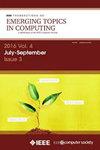A Bio-Inspired Implementation of a Sparse-Learning Spike-Based Hippocampus Memory Model
IF 5.4
2区 计算机科学
Q1 COMPUTER SCIENCE, INFORMATION SYSTEMS
IEEE Transactions on Emerging Topics in Computing
Pub Date : 2024-04-16
DOI:10.1109/TETC.2024.3387026
引用次数: 0
Abstract
The brain is capable of solving complex problems simply and efficiently, far surpassing modern computers. In this regard, neuromorphic engineering focuses on mimicking the basic principles that govern the brain in order to develop systems that achieve such computational capabilities. Within this field, bio-inspired learning and memory systems are still a challenge to be solved, and this is where the hippocampus is involved. It is the region of the brain that acts as a short-term memory, allowing the learning and storage of information from all the sensory nuclei of the cerebral cortex and its subsequent recall. In this work, we propose a novel bio-inspired hippocampal memory model with the ability to learn memories, recall them from a fragment of itself (cue) and even forget memories when trying to learn others with the same cue. This model has been implemented on SpiNNaker using Spiking Neural Networks, and a set of experiments were performed to demonstrate its correct operation. This work presents the first simulation implemented on a special-purpose hardware platform for Spiking Neural Networks of a fully functional bio-inspired spike-based hippocampus memory model, paving the road for the development of future more complex neuromorphic systems.基于稀疏学习尖峰的海马记忆模型的生物启发实现
人脑能够简单有效地解决复杂问题,远远超过现代计算机。在这方面,神经形态工程的重点是模仿控制大脑的基本原理,以开发具有这种计算能力的系统。在这个领域,生物启发的学习和记忆系统仍然是一个有待解决的挑战,而这正是海马体参与的地方。它是大脑中充当短期记忆的区域,允许从大脑皮层的所有感觉核中学习和存储信息并随后回忆。在这项工作中,我们提出了一种新的生物启发海马记忆模型,该模型具有学习记忆的能力,可以从自己的片段(线索)中回忆起它们,甚至在试图用相同的线索学习其他人时忘记记忆。利用Spiking神经网络在SpiNNaker上实现了该模型,并通过一系列实验验证了该模型的正确性。这项工作首次在一个专用硬件平台上实现了基于全功能生物激发的海马记忆模型的脉冲神经网络仿真,为未来更复杂的神经形态系统的发展铺平了道路。
本文章由计算机程序翻译,如有差异,请以英文原文为准。
求助全文
约1分钟内获得全文
求助全文
来源期刊

IEEE Transactions on Emerging Topics in Computing
Computer Science-Computer Science (miscellaneous)
CiteScore
12.10
自引率
5.10%
发文量
113
期刊介绍:
IEEE Transactions on Emerging Topics in Computing publishes papers on emerging aspects of computer science, computing technology, and computing applications not currently covered by other IEEE Computer Society Transactions. Some examples of emerging topics in computing include: IT for Green, Synthetic and organic computing structures and systems, Advanced analytics, Social/occupational computing, Location-based/client computer systems, Morphic computer design, Electronic game systems, & Health-care IT.
 求助内容:
求助内容: 应助结果提醒方式:
应助结果提醒方式:


